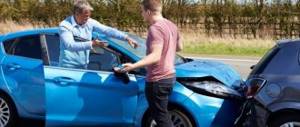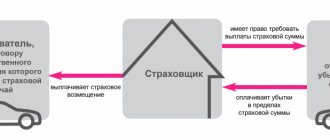The experience of subrogation disputes regarding the transfer of compensation obligations to insurance companies and individuals who are legally recognized as victims of road accidents and are the objects of compulsory motor liability insurance) is widely described in legal practice.
However, these stories and professional comments on them, a review of law enforcement practice, are not replete with recommendations for solving these unpleasant situations. On the one hand, this is justified: why publish practical recommendations in the legal field in the public domain, when you can use them, accumulated experience, directly for legal advice on the spot, and receive additional income from professional activities? However, the magazine “Legal Guarantee” and the portal “Zasudili.ru” serve precisely the interests of people, which is why practical solutions described below are proposed here. Let us analyze the practical situation on the topic of subrogation and consider possible solutions in the legal field, solutions necessary to protect the defendant.
In 2015, citizen X, who issued a compulsory motor liability insurance policy in a timely manner, was found to be at fault for the accident. The injured party has a CASCO policy, the guilty party has a compulsory motor liability insurance policy. The drivers did not agree to resolve the situation without the traffic police, and its solution in the “Euro protocol” format is impossible under the terms of the CASCO policy of one of the parties. After the protocols are drawn up and the participants in the car accident visit the traffic police, the insurance companies of the victim and those responsible for the accident come into play. In the absence of an agreement to estimate the cost of repairs, a technical examination is carried out, to which the person responsible for the accident is not even invited; not required by law.
As a result of the examination, relatively small damage was assessed, just over 50,000 rubles. The insurance company of the person responsible for the accident soon paid the required compensation to the insurance company from the injured party, but the insurance companies did not agree on the amount and disputed (without the participants in the accident or their notification) the difference of 13,000 rubles - for two and a half years, in In particular, the insurance company of the guilty party filed an appeal against the decision of the Arbitration Court to the Supreme Court. However, in the end, a decision was made to leave the decision of the Arbitration Court unchanged, and the disputed amount had to be recovered from citizen X, who was found guilty of the accident.
The three-year period was not missed, so citizen X received a demand for a voluntary payment of 13,000 rubles to the account of the injured party’s insurance company. The pre-trial claim states that, in accordance with Art. 1072 of the Civil Code of the Russian Federation, as well as the Resolution of the Constitutional Court of the Russian Federation dated March 10, 2017, X must pay the difference between the actual damage and the insurance compensation paid by the insurance company acting on his part. The amount of damage caused did not exceed the maximum amount of insurance compensation, which in 2015 amounted to 120,000 rubles. and by virtue of the law, recovered from the insurance company (clause c, article 7 of the Federal Law of April 25, 2002 N 40-FZ “On compulsory insurance of civil liability of vehicle owners” (as amended by the Federal Law of July 21, 2014 N 223-FZ )). Thus, the insurance company of the guilty party compensated the amount of damage in the amount of 46,013.61 rubles. (38,200 rubles - voluntarily and in court - 7,813 rubles 61 kopecks).
X, who had a compulsory motor liability insurance policy and had previously fulfilled all the insurance conditions as a law-abiding citizen, did not voluntarily pay the claim of the insurance injured party, and was soon summoned to a magistrate’s court hearing at his place of registration as a defendant in a subrogation case. The decision of the magistrate was justified by Art. Art. 15, 965, 1064, 1072, 1079 of the Civil Code of the Russian Federation, Decree of the Constitutional Court dated March 10, 2017 No. 6-P, Federal Law “On compulsory insurance of civil liability of vehicle owners” No. 40 dated April 25, 2002, Government Decree No. 263, other regulations - legal acts, and stated to recover from X in favor of the plaintiff - the insurance company of the injured party - the amount of approximately 13 thousand rubles and the amount of state duty.
The application to appeal the decision of the first instance court was sent to the district court within the deadlines. When considering the case in the district court, nuances were identified in which we can recommend certain tactics for dealing with such disputes.
The examination was carried out without the participation of the defendant.
There are nuances in such cases - in the court of first instance it is necessary to insist on a re-examination. If the court refuses this requirement, then on appeal this decision must be overturned. Even if the initiator-defendant does not pay for it (promise, but not pay), the court will oblige it to be carried out, since advance payment for the examination when applying for it in court is not provided for by law. Having collected and examined the case materials, previous examinations, this step is a real reason to reconsider the claims of the plaintiff insurance company and refuse to satisfy the claim. Few people know this. Direct participants in road accidents - drivers in such cases, as a rule, are not involved in the examination - insurance companies do everything themselves. There are a lot of such cases now. If you received an insurance claim for subrogation or, as it is clearly called, “On the collection of insurance compensation (payments) (property insurance) under a CASCO agreement,” since the injured party had a CASCO policy, you are not obliged to pay the entire amount that is required of you plaintiff insurance company. Statistics from law enforcement practice, according to the judge, are such that the amount of subrogation claims is overestimated by an average of 25-40%. It is possible to identify and prove this excess both pre-trial and in court - in different steps. In addition, according to the Constitutional Court Resolution of March 10, 2017, damage can be claimed with the deduction of wear and tear of the parts being replaced.
What is subrogation in compulsory motor liability insurance?
The Latin word "subrogation" literally means "substitution." In the legislation of the Russian Federation, the concept is introduced by the Civil Code in Article 965. In accordance with it, subrogation is understood as the right to recover losses from the causer, which the insurer has already covered for the insured person.
In practice, subrogation under compulsory motor liability insurance from the culprit of an accident looks like this. After an insured event occurs, the insurance company compensates for the damage caused to the property of the insured person. The organization can send a demand for compensation to the at-fault driver, who is obliged to compensate for the payments made, compensating for the damage caused to others.
When the insurer fulfills its obligations to the insured, subrogation occurs. This means that the culprit of the accident no longer owes the victim anything, but his debt has been transferred to the insurance company.
Subrogation is allowed only for property insurance. It cannot be used for health or life insurance coverage.
Features of regression
In insurance practice, this concept is used as the right of the company to reclaim the culprit of the incident. Despite the fact that they are exempt from compensating the damage caused to the required extent to the injured party, they are still obliged to pay the expenses incurred by the company.
Such a right can be applied in such cases as:
- intentional harm to the health and life of the insured;
- property damage;
- causing losses when driving while drunk or under the influence of drugs;
- if the citizen did not have rights to the vehicle during the management of which the insured event occurred;
- when fleeing the scene of an accident;
- if the culprit of the incident was not indicated in the insurance contract as a person allowed to drive transport;
- when a CASCO accident occurred during a period not covered by the mandatory policy agreement.
How is subrogation different from recourse?
The at-fault driver may not know the difference between subrogation and subrogation. In each case, the victim receives compensation. However, after a certain time, the insurer sends a notice demanding payment of a certain amount.
The difference between the concepts lies in the source of the requirements. Subrogation can be claimed by the victim's insurance organization, since it was the one who received such a right from the victim. The limitation period for a claim does not depend on the transfer of rights. This means that by subrogation it starts from the same date as in the usual manner - from the date of the traffic accident.
Recourse claims can be made by the insurance organization of the at-fault driver, since he has received the opportunity to make a claim against the insured (the Law “On Compulsory Motor Liability Insurance” in Article 12 regulates cases when regressive claims arise). At the same time, the Civil Code in Article 200, paragraph 3, determines that for regressive claims, the limitation period begins to count from the date of compensation for damage to the victim.
Features of registration of road accidents during traffic
To record a violation by several drivers, it is necessary to follow the basic rules of action after an incident occurs. The first stage is calling a traffic police officer. To make a decision, you need to describe the circumstances of the accident and clearly formulate the degree of guilt for entering data into the document.
Drivers have the right to independently resolve the conflict without calling an inspector. If two cars are involved, each has a valid MTPL policy, and there is no threat to the life and health of individuals, citizens can draw up a Europrotocol. When filling out this document, car owners will be paid half of the fixed amount of compensation provided for in the clauses of the agreement with the insurance company.
Real cases from judicial practice on subrogation under the current compulsory motor liability insurance
Today, road accidents have become commonplace. Insurance organizations are constantly faced with the need to compensate for damage. Their requests are not always lawful, everyone knows this, including judges. Let's look at examples of real litigation.
Situation 1. The car of a victim in an accident received damage worth 573 thousand rubles
The guilty driver did not deny his own guilt; he was ready to compensate for the damage caused. The costs of restoration were fully covered by his insurer, since the parties only had compulsory motor liability insurance policies.
However, the law “On Compulsory Motor Liability Insurance” regulates the maximum payment in the amount of 400 thousand rubles. Therefore, the court ordered the driver at fault in the incident to compensate the difference of 173 thousand rubles.
Situation 2. After an accident, vehicles need to be sent for restoration, the amount of damage is 300 thousand rubles
The insurance premium to the victim was paid from the funds of the insurance organization of the person responsible for the incident.
During the trial, it was established that the driver was not the initiator of the accident. The incident occurred under the influence of other factors, so the insurer could not use the right of subrogation.
As a result, the restoration of the victim’s car was carried out at the expense of the auto insurance policy.
Situation 3. After the accident, the victim was paid all the money required to restore the vehicle
The insurer covered the costs; over time, he demanded subrogation from the client in the amount of 88 thousand rubles. The court found that the traffic accident certificate did not include all the items. The judge noted and remembered this, so the decision was made in favor of the motorist.
An additional examination of the damaged vehicle was carried out, the estimated amount turned out to be 35 thousand more than indicated in the document, therefore the insurance company of the at-fault motorist is obliged to cover the costs of the injured driver.
Why is subrogation needed?
This institution is used as legal protection for insurers in the event of relevant cases of comprehensive insurance. Thus, companies want to distance themselves from fraudulent schemes and other circumstances.
Subrogation is a new concept in domestic legislation. Sometimes its use is associated with a number of difficulties. But at the same time, insurance subrogation protects the rights of both parties.
It looks like this: the injured party receives its compensation for damage in one case or another CASCO and is then freed from subsequent worries related to relations with the perpetrator of the incident. And the insurance company, through subrogation, can maintain its reserves, which are used for payments.
Compensation for damage in case of mutual fault
In order to receive payments in case of an accident with mutual fault, it is necessary to correctly document the incident. From the first moments after a collision, it is important to follow all the rules of behavior prescribed in this situation.
First actions in case of an accident
The algorithm of actions of both drivers after an accident is standard.
- First of all, you need to turn off the car engine and put it on the handbrake to prevent unplanned movement and collision with other cars. Under no circumstances should you leave the scene of the accident or try to change the scene of the accident.
- Drivers must install warning triangles on both sides of colliding vehicles.
- You must refrain from moving vehicles or parts left on the road after an accident.
- It is necessary to ensure that none of the drivers of the colliding cars or their passengers are seriously injured. If injuries are detected, you should immediately call an ambulance.
- There is no need to enter into conflict with the driver of the second car. If possible, it is better to try to calm him down and start filing the accident together.
- Be sure to call a traffic police officer to the scene of the accident. Before his arrival, you should film the position of the cars, existing signs, road markings, and damage received. Also, if you have a video recorder, it is better to save a recording of the accident and provide it to the traffic police inspector.
- After the traffic police arrive, you need to describe in detail the circumstances of the accident, what actions of the drivers led to the collision. Draw the inspector's attention to evidence of the guilt of the second driver and ensure that the testimony is entered into the protocol.
- There is no need to admit guilt at this stage. Perhaps, after studying the materials, traffic police will come to the conclusion that one person is to blame for the collision. Accordingly, the second driver will receive compensation in full.
For more information about what to do in case of an accident in 2021, read here: there was an accident - what to do in 2021.
If one of the drivers is more at fault, you need to go to court to consider the degree of guilt and the amount of payments. When a mutual accident occurs, payment under compulsory motor liability insurance is made in equal parts, unless one of the participants is proven to be at fault.
What documents are required
After completing the procedure for recording an accident, each driver must have a set of documents issued by the traffic police. It includes:
- a document confirming the fact of the accident;
- protocol;
- decision on the violation committed.
The protocol must include:
- accident diagram;
- results of measurements taken by the police;
- explanations of each of the participants in the accident;
- description of the damage received by the vehicles, identified during inspection by the traffic police officer.
How are payments calculated?
Most often, compensation is paid in equal parts to both those responsible for the collision. This is done in cases where:
- it is not possible to establish the degree of guilt;
- in the absence of litigation.
If the court nevertheless determines how guilty each driver is, then payments are distributed in proportion to the established degree of guilt. The greater the share of fault of the car owner, the less his share of payments.
For example, when the first driver contributed 80% of the collision and the second only 20%, the first driver is paid 20% of the total compensation, and the rest (80%) goes to the less at-fault driver.
What to do when you receive a notification
If the insurance company has made a subrogation claim as the at-fault party, everything must be done within the rules that govern the relationship between the two parties.
You should wait until the victim submits all documents and evidence to the appropriate structure, which can be used to determine guilt. In cases where he has waived his claims against the person who is responsible for the losses incurred, which were compensated by the insurance company, then it should not pay him compensation and may demand a refund if payment has already been made earlier.
Under what conditions does subrogation appear?
To make subrogation possible under compulsory motor liability insurance, the following conditions must be met:
- the insurance organization fully compensated the damage to the victim;
- the victim has CASCO insurance;
- the cost of restoring the victim’s car exceeds the maximum amount for the car insurance policy.
From each person at fault in the accident (pedestrian, driver without compulsory motor insurance or cyclist), the insurer can recover damages through subrogation.
Attention! The victim is not subject to subrogation requirements, even if he is at fault. For example, he lost control and drove into a pole. If the car is registered to a legal entity, then it is the organization that is obliged to make the subrogation payment, and not the driver who was driving the car.








